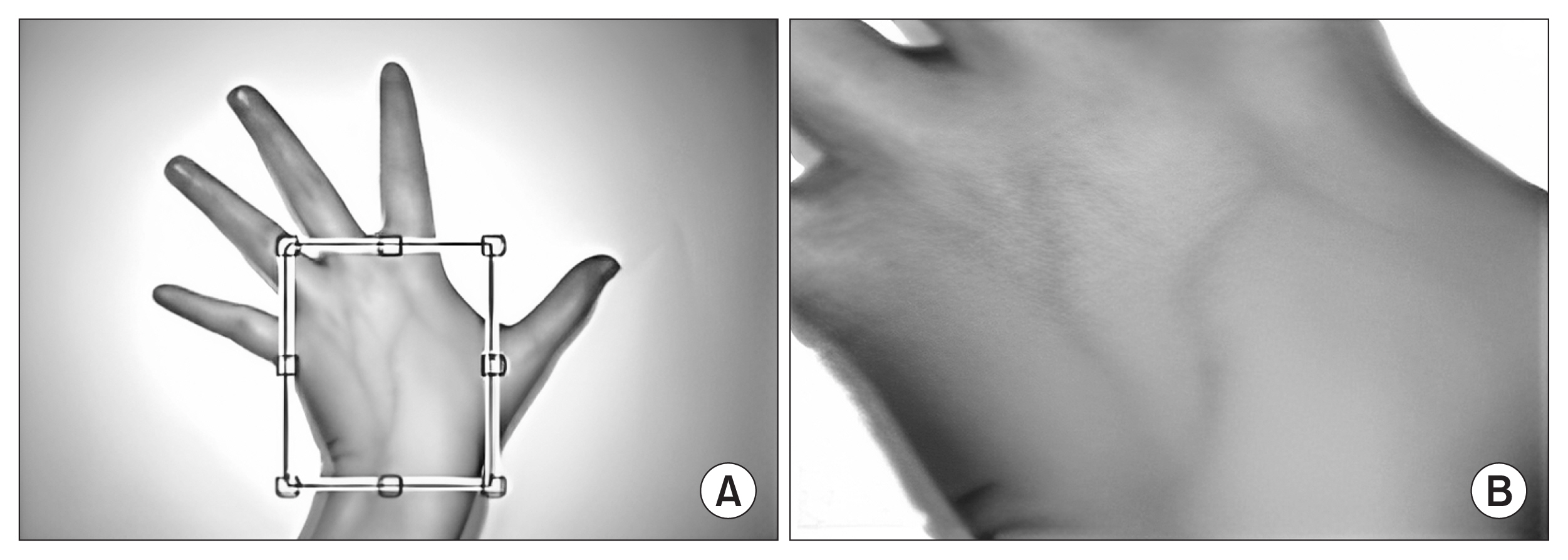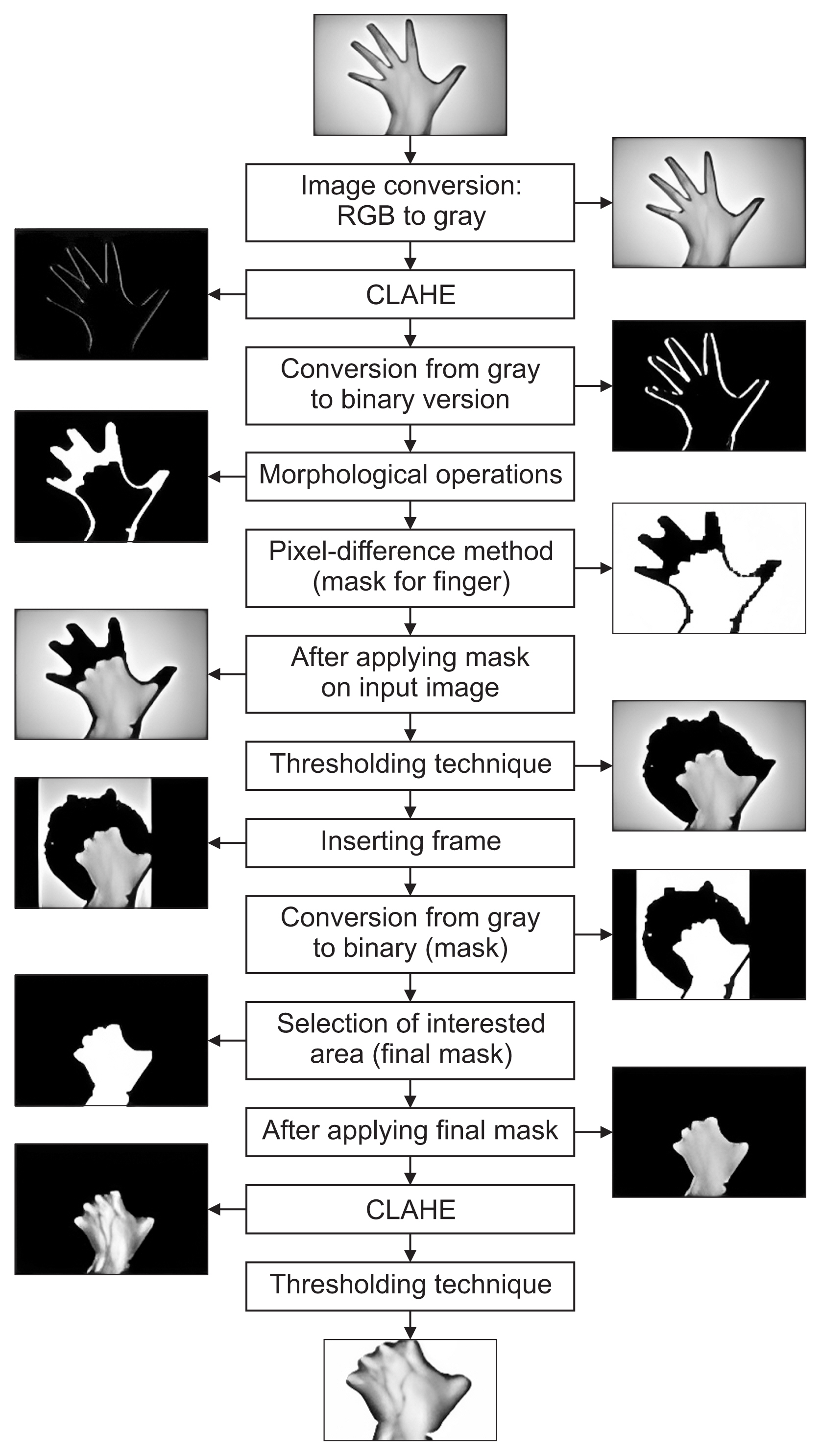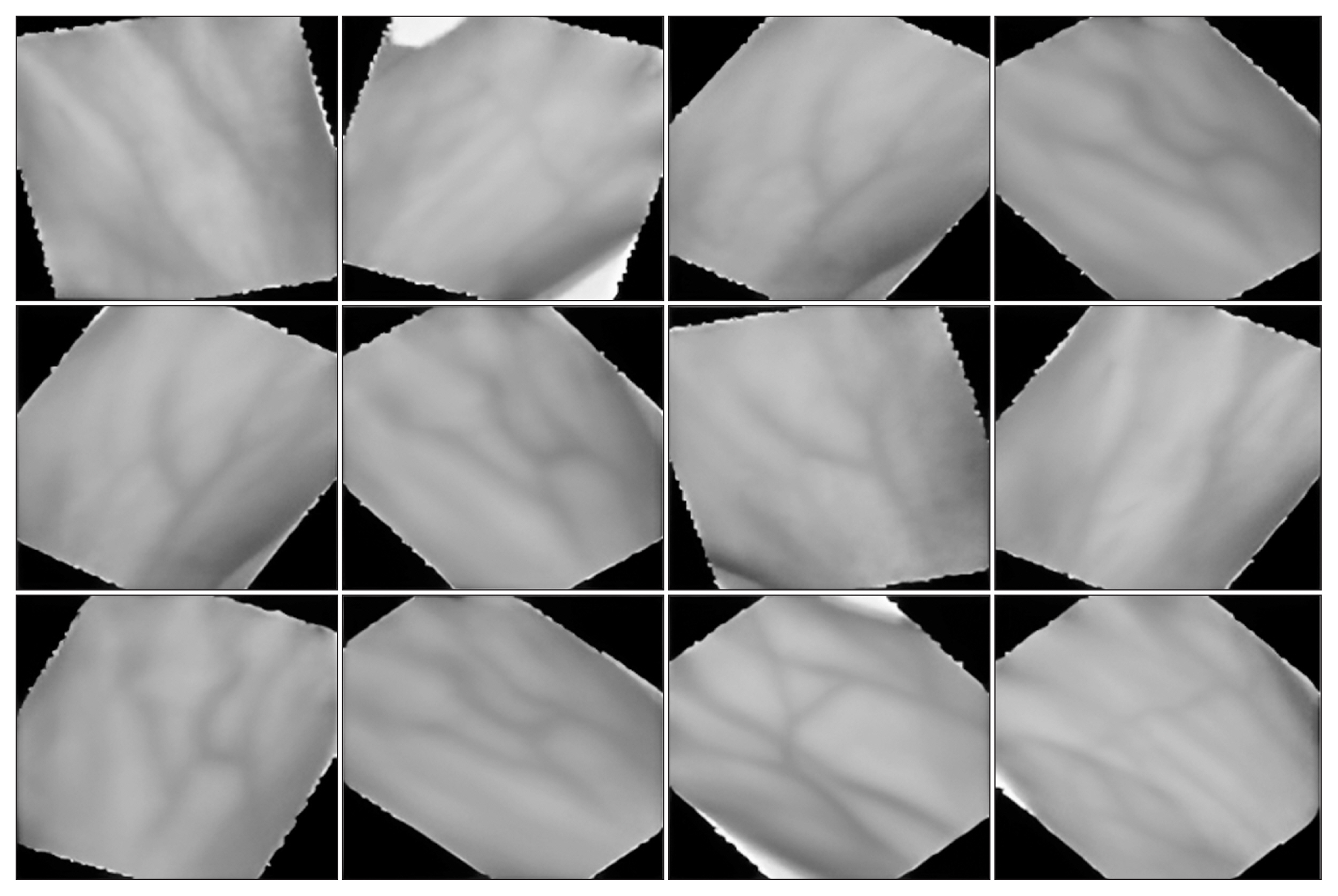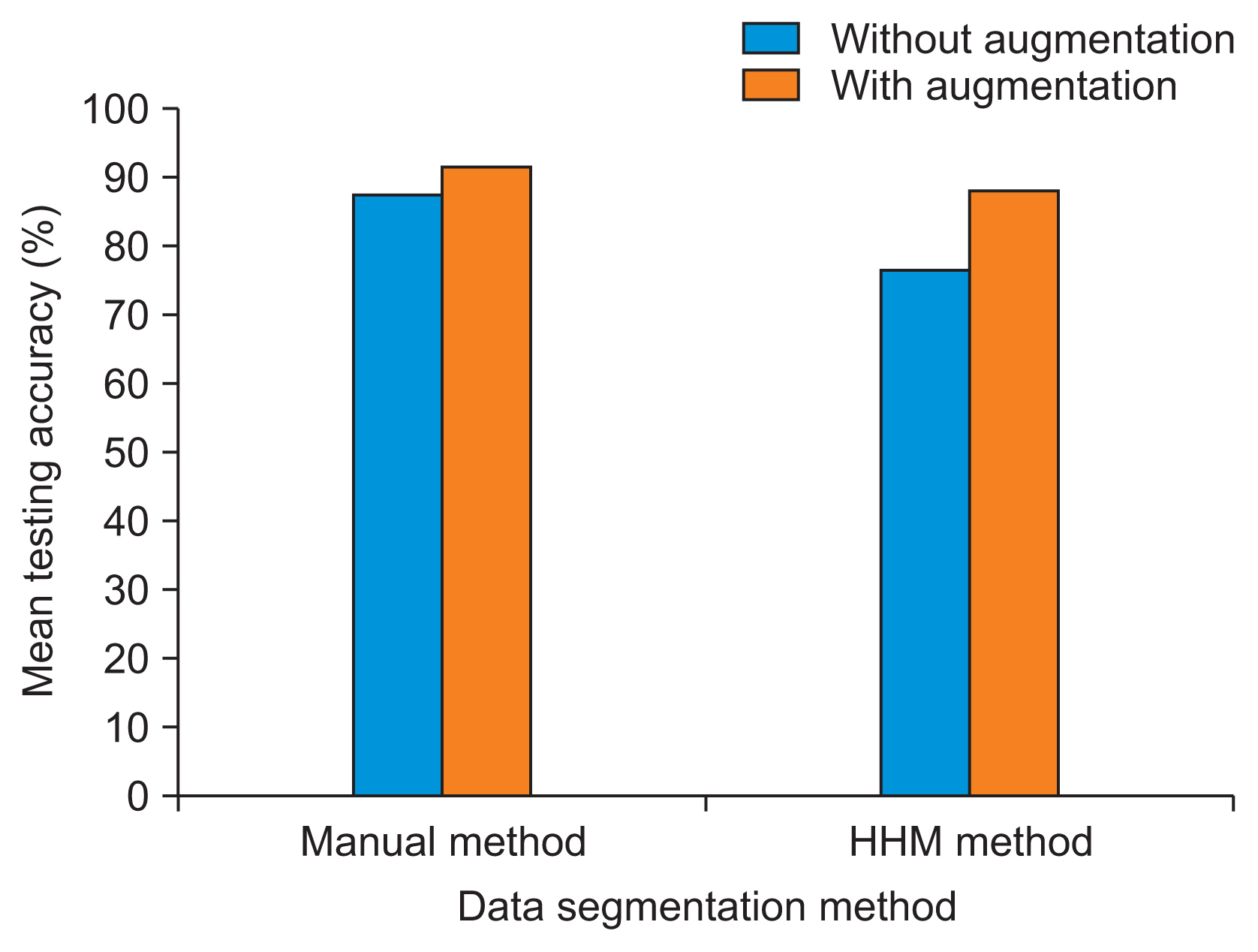Healthc Inform Res.
2023 Apr;29(2):152-160. 10.4258/hir.2023.29.2.152.
Dorsal Hand Vein Pattern Recognition: A Comparison between Manual and Automatic Segmentation Methods
- Affiliations
-
- 1Department of Electronic Engineering, Faculty of Electrical and Electronic Engineering, Universiti Tun Hussein Onn Malaysia, Johor, Malaysia
- KMID: 2542141
- DOI: http://doi.org/10.4258/hir.2023.29.2.152
Abstract
Objectives
Various techniques for dorsal hand vein (DHV) pattern extraction have been introduced using small datasets with poor and inconsistent segmentation. This work compared manual segmentation with our proposed hybrid automatic segmentation method (HHM) for this classification problem.
Methods
Manual segmentation involved selecting a region-of-interest (ROI) in images from the Bosphorus dataset to generate ground truth data. The HHM combined histogram equalization and morphological and thresholding-based algorithms to localize veins from hand images. The data were divided into training, validation, and testing sets with an 8:1:1 ratio before training AlexNet. We considered three image augmentation strategies to enlarge our training sets. The best training hyperparameters were found using the manually segmented dataset.
Results
We obtained a good test accuracy (91.5%) using the model trained with manually segmented images. The HHM method showed slightly inferior performance (76.5%). Considerable improvement was observed in the test accuracy of the model trained with the inclusion of automatically segmented and augmented images (84%), with low false acceptance and false rejection rates (0.00035% and 0.095%, respectively). A comparison with past studies further demonstrated the competitiveness of our technique.
Conclusions
Our technique can be feasible for extracting the ROI in DHV images. This strategy provides higher consistency and greater efficiency than the manual approach.
Figure
Reference
-
References
1. Chowdhury AM, Imtiaz MH. Contactless fingerprint recognition using deep learning: a systematic review. J Cybersecur Priv. 2022; 2(3):714–30. https://doi.org/10.3390/jcp2030036.
Article2. Laghari WA, Tay KG, Huong A, Choy YY, Chew CC. Dorsal hand vein identification using transfer learning from AlexNet. Int J Integr Eng. 2022; 14(3):111–9. https://doi.org/10.30880/ijie.2022.14.03.012.
Article3. Dhieb T, Boubaker H, Njah S, Ben Ayed M, Alimi AM. A novel biometric system for signature verification based on score level fusion approach. Multimed Tools Appl. 2022; 81(6):7817–45. https://doi.org/10.1007/s11042-022-12140-7.
Article4. Zulfiqar M, Syed F, Khan MJ, Khurshid K. Deep face recognition for biometric authentication. In : Proceedings of 2019 International Conference on Electrical, Communication, and Computer Engineering (ICECCE); 2019 Jul 24–25; Swat, Pakistan. p. 1–6. https://doi.org/10.1109/ICECCE47252.2019.8940725.
Article5. Nithya AA, Lakshmi C. Iris recognition techniques: a literature survey. Int J Appl Eng Res. 2015; 10(12):32525–46.6. Jia W, Xia W, Zhang B, Zhao Y, Fei L, Kang W, et al. A survey on dorsal hand vein biometrics. Pattern Recognit. 2021; 120:108122. https://doi.org/10.1016/j.patcog.2021.108122.
Article7. Kumar R, Singh RC, Kant S. Dorsal hand vein-biometric recognition using convolution neural network. Gupta D, Khanna A, Bhattacharyya S, Hassanien AE, Anand S, Jaiswal A, editors. International Conference on Innovative Computing and Communications. Singapore: Springer;2021. 1087–107. https://doi.org/10.1007/978-981-15-5113-0_92.
Article8. Rajalakshmi M, Ganapathy V, Rengaraj R. Palm-dorsal vein pattern authentication using convoluted neural network (CNN). Int J Pure Appl Math. 2017; 116(23):525–32.9. Raghavendra R, Surbiryala J, Busch C. Hand dorsal vein recognition: Sensor, algorithms and evaluation. In : Proceedings of 2015 IEEE International Conference on Imaging Systems and Techniques (IST); 2021 Sep 16–18; Macau, China. 1–6. https://doi.org/10.1109/IST.2015.7294557.
Article10. Khan MH, Khan NA. Investigating linear discriminant analysis (LDA) on dorsal hand vein images. In : Proceedings of the 3rd International Conference on Innovative Computing Technology (INTECH); 2013 Aug 29–31; London, UK. p. 54–9. https://doi.org/10.1109/INTECH.2013.6653626.
Article11. Al-johania NA, Elrefaei LA. Dorsal hand vein recognition by convolutional neural networks: feature learning and transfer learning approaches. Int J Intell Eng Syst. 2019; 12(3):178–91. https://doi.org/10.22266/IJIES2019.0630.19.
Article12. Li X, Huang D, Wang Y. Comparative study of deep learning methods on dorsal hand vein recognition. Biometric recognition. Cham, Switzerland: Springer;2016. 296–306. https://doi.org/10.1007/978-3-319-46654-5_33.
Article13. Mohaghegh M, Payne A. Automated biometric identification using dorsal hand images and convolutional neural networks. J Phys Conf Ser. 2021; 1880:012014. https://doi.org/10.1088/1742-6596/1880/1/012014.
Article14. Wang J, Wang G. Quality-specific hand vein recognition system. IEEE Trans Inf Forensic Secur. 2017; 12(11):2599–610. https://doi.org/10.1109/TIFS.2017.2713340.
Article15. Guo Z, Ma Y, Min X, Li H, Liu Q, Han C, et al. A novel algorithm of dorsal hand vein image segmentation by integrating matched filter and local binary fitting level set model. In : Proceedings of 2020 7th International Conference on Information Science and Control Engineering (ICISCE); 2020 Dec 18–20; Changsha, China. p. 81–5. https://doi.org/10.1109/ICISCE50968.2020.00027.
Article16. Chanthamongkol S, Purahong B, Lasakul A. Dorsal hand vein image enhancement for improve recognition rate based on SIFT keypoint matching. In : Proceedings of the 2nd International Symposium on Computer, Communication, Control and Automation; 2013 Dec 1–2; Singapore. p. 174–7. https://doi.org/10.2991/3ca-13.2013.44.
Article17. Sontakke BM, Humbe VT, Yannawar PL. Automatic ROI extraction and vein pattern imaging of dorsal hand vein images. Int J Sci Adv Res Technol. 2018; 4(3):1678–83.18. Manju RA, Koshy G, Simon P. Improved method for enhancing dark images based on CLAHE and morphological reconstruction. Procedia Comput Sci. 2019; 165:391–8. https://doi.org/10.1016/j.procs.2020.01.033.
Article19. Chen L, Zheng H, Li L, Xie P, Liu S. Near-infrared dorsal hand vein image segmentation by local thresholding using grayscale morphology. In : Proceedings of 2007 1st International Conference on Bioinformatics and Biomedical Engineering; 2007 Jul 6–8; Wuhan, China. p. 868–71. https://doi.org/10.1109/ICBBE.2007.226.
Article20. Sheet SS, Tan TS, As’ari MA, Hitam WH, Sia JS. Retinal disease identification using upgraded CLAHE filter and transfer convolution neural network. ICT Express. 2022; 8(1):142–50. https://doi.org/10.1016/j.icte.2021.05.002.
Article21. Hitam MS, Awalludin EA, Yussof WN, Bachok Z. Mixture contrast limited adaptive histogram equalization for underwater image enhancement. In : Proceedings of 2013 International Conference on Computer Applications Technology (ICCAT); 2013 Jan 20–22; Sousse, Tunisia. p. 1–5. https://doi.org/10.1109/ICCAT.2013.6522017.
Article22. Chin SW, Tay KG, Chew CC, Huong A, Rahim RA. Dorsal hand vein authentication system using artificial neural network. Indones J Electr Eng Comput Sci. 2021; 21(3):1837–46. http://doi.org/10.11591/ijeecs.v21.i3.pp1837-1846.
Article23. Akram MU, Awan HM, Khan AA. Dorsal hand veins based person identification. In : Proceedings of 2014 4th International Conference on Image Processing Theory, Tools and Applications (IPTA); 2014 Oct 14–17; Paris, France. p. 1–6. https://doi.org/10.1109/IPTA.2014.7001975.
Article24. Hofbauer H, Jalilian E, Uhl A. Exploiting superior CNN-based iris segmentation for better recognition accuracy. Pattern Recognit Lett. 2019; 120:17–23. https://doi.org/10.1016/j.patrec.2018.12.021.
Article25. LeCun Y, Bottou L, Bengio Y, Haffner P. Gradient-based learning applied to document recognition. Proc IEEE. 1998; 86(11):2278–324. https://doi.org/10.1109/5.726791.
Article26. Lefkovits S, Lefkovits L, Szilagyi L. CNN approaches for dorsal hand vein based identification. In : Proceedings of International Conference in Central Europe on Computer Graphics, Visualization and Computer Vision (WSCG); Plzen, Czech Republic. p. 51–60. https://doi.org/10.24132/CSRN.2019.2902.2.7.
Article27. Malik J, Girdhar D, Dahiya R, Sainarayanan G. Reference threshold calculation for biometric authentication. Int J Image Graph Signal Process. 2014; 2:46–53. https://doi.org/10.5815/ijigsp.2014.02.06.
Article28. Wijewickrama R, Maiti A, Jadliwala M. Write to know: on the feasibility of wrist motion based user-authentication from handwriting. In : Proceedings of the 14th ACM Conference on Security and Privacy in Wireless and Mobile Networks; 2021 Jun 28–Jul 2; Abu Dhabi, United Arab Emirates. p. 335–46. https://doi.org/10.1145/3448300.3468290.
Article29. Picart-Armada S, Barrett SJ, Wille DR, Perera-Lluna A, Gutteridge A, Dessailly BH. Benchmarking network propagation methods for disease gene identification. PLoS Comput Biol. 2019; 15(9):e1007276. https://doi.org/10.1371/journal.pcbi.1007276.
Article30. Junyulong Technology. Junyulong Technology product center live biometrics [Internet]. Shenzhen, China: Junyulong Technology;c2021. [cited at 2023 Mar 30]. Available from: http://www.junyulong.com.cn/product/html/284.html.
- Full Text Links
- Actions
-
Cited
- CITED
-
- Close
- Share
- Similar articles
-
- Diagnostic Availability of Optical Coherence Angiography in Type 1 and 2 Choroidal Neovascularization
- Volume Measurement of the Intracranial Aneurysm: A Discussion and Comparison of the Alternatives to Manual Segmentation
- Classification of Continuous Heart Sound Signals Using the Ergodic Hidden Markov Model
- Automatic Segmentation and Radiologic Measurement of Distal Radius Fractures Using Deep Learning
- Three-dimensional (3D) auto-segmentation of vascular structures and hepatic sectional parenchyme of living liver donors using computed tomographic angiography: a deep learning model for automatic 3D volumetry






